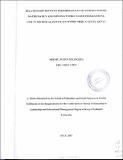| dc.description.abstract | The poor performance in Structured Programming unit in Kenya National Examinations Council (KNEC) examination for Diploma in Information Communication Technology (DICT) programme by students in module one has caused a great outcry in most of the Technical Institutes in Kenya and more so at managerial levels in Meru County. This poor performance in Structured Programming unit has made many students in DICT module one level to stagnate at this level without successfully progressing to the next level, which is module two. This trend has directly led to a reduction of students' enrollment in these institutions, thus triggering a lot of challenges in decision making at managerial levels. This poor performance by trainees in structured programming unit has been continuously linked to their poor performance in Mathematics examination in Kenya Certificate of
econdary Education (KCSE). The purpose of this study was therefore, to determine the relationship between the students' performance in secondary school mathematics and diploma's Structured Programming unit in technical institutes within Meru County, Kenya. The researcher used a correlational research design. The target population was 124. It was composed of all the 118 students that had sat for the KNEC examination in Structured Programming unit from the year 2012 to 2015 in Meru, Kiirua and Nkabune technical institutes within Meru County, and the six lecturers that had taught them in the Structured Programming unit. Since the target population was relatively small, all the subjects were taken as respondents. The instruments for data collection were a structured questionnaire that was filled by the lecturers and a document analysis schedule that was used by the researcher to capture the students' performances in KCSE mathematics and DTCT Structured Programming unit. The researcher carried out a pilot study in Meru National Polytechnic to enhance the quality of research instruments with a sample size of I 0
omposed of eight students that had sat for KNEC examination in Structured Programming unit in the year 2011 and two lecturers that had prepared them. Data analysis was then done using SPSS computer software version 16.0. The statistical tools used to analyze the data were Pearson correlation coefficient, analysis of variance (ANOV A), coefficient of determination and scatter plots. Testing of h othesis was done at 0.05 level of confidence. After a thorough analysis of the
dents' performance in KCSE mathematics and Structured Programming xarninations from the year 2012 to 2015, the study established that there is no significant relationship between the students' performance in secondary school ma h matics and diploma's Structured Programming unit in technical institutes • hin Meru County, Kenya (r = 0.098, p = 0.29 L a= 0.05, R2 = 0.0 l 0, adjusted R2 = 0.001./ = 1.124). Therefore, a student's performance in KCSE mathematics does not t rmine or influence a student's performance in Structured Programming unit.
Further research should therefore be carried out to determine the real causes of students' poor performance in Structured Programming unit in the KNEC xamination for DICT module one programme, so that the poor performance being 'irnessed in this subject can be thwarted and avert the DICT programme from oming extinct. | en_US |

